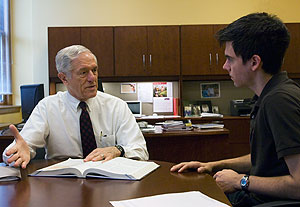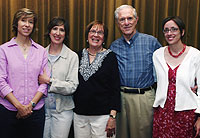Salvatore P. Sutera, Ph.D., interim dean of the School of Engineering & Applied Science and senior professor of biomedical engineering, began his long, distinguished career at Washington University as chair of mechanical engineering in August 1968.
As the nation raged with revolutionary fury that month, Sutera, sitting in the tranquility of his office in Cupples II Hall, could have had little inkling that, 40 years later, he would be heading the school that brought him from Brown University to establish a research linkage between mechanical engineering and the WUSTL School of Medicine.

In those 40 years, Sutera has done that and much more, serving the University in a variety of capacities and making important contributions to biomedical engineering and the entire School of Engineering.
“When I came here, I was working on some fluid mechanics problems related to blood flow in the capillaries that I’d started at Brown, which then didn’t have a medical school,” Sutera says. “Washington University was very attractive to me because of its fine medical school.It wasn’t long after arriving here that I was part of joint grants with professors in chemical engineering and cardiothoracic surgery. Later on, I found great collaborators in hematology, internal medicine and pathology.
“I enjoyed a really good, long, 25-year run in research funded mostly by the National Institutes of Health,” he says. “Most of my collaborators are now retired from research, as am I, but now I’m keeping active as an administrator.”
Sutera retired from the duties of chair of mechanical engineering in 1982, but, after a hiatus of three years, he returned as permanent chair in 1985. He remained in that capacity until 1996; that made a total of 25 years in that post.
When the announcement was made of the formation of the new Department of Biomedical Engineering in 1996, Sutera served as acting chair of that department. At the same time, he ran the search committee for a permanent chair. The committee’s quest was successful and short. In the summer of 1997, the current chair, Frank C. P. Yin, M.D., Ph.D., took over and was soon installed as the Stephen F. and Camilla T. Brauer Distinguished Professor of Biomedical Engineering.
Sutera has long been recognized for his work in biomechanics, with particular emphasis on the degradation of blood in artificial organs, including flow-induced thrombosis and the pathophysiology of red blood cells and platelets. Before becoming attracted to problems of blood flow, Sutera’s research interests dealt with fluid drag reduction by boundary-layer control and the effects of turbulence on heat transfer, among other topics.
Before coming to WUSTL, Sutera was a member of the Brown University engineering faculty from 1960-68. During his last two years at Brown, he was executive officer of its Division of Engineering.
Sutera had several industrial experiences from 1953-57, including the Glen L. Martin Co., Baltimore; North American Aviation, Downey, Calif.; E.I. duPont de Nemours & Co., Newark, N.J., and Wilmington, Del.; and Electro-Optical Systems Inc., Pasadena, Calif.
He earned a bachelor’s degree in mechanical engineering in 1954 from Johns Hopkins University and a master’s degree and doctorate in mechanical engineering from the California Institute of Technology in 1955 and 1960, respectively.

Planting the seed
A native of Baltimore, Sutera credits his education at the Baltimore Polytechnic Institute, a highly competitive engineering prep school, with getting him off to a good start in academia.
“Baltimore Poly had an accelerated curriculum that challenged me,” he says. “If you did well in four years there, schools like Johns Hopkins would admit you directly as a sophomore. So, I finished my bachelor’s in just three years.”
Sutera is the older son of Philip and Anna Sutera. His father emigrated from Sicily in 1918, and his mother was born in Baltimore. He was the first Sutera to attend college. At Hopkins, he met a couple of professors who had degrees from the California Institute of Technology, and they got him interested in the famous school.
“Working on my master’s degree, I met a professor who became my dissertation mentor, and he got me involved in biological questions and planted the first seed,” Sutera says.
His stint at DuPont put him in contact with many researchers who had earned doctorates, and they inspired him to go back to Cal Tech in 1957. His doctoral research focused on the optical properties of flowing suspensions of macromolecules, in particular tobacco mosaic virus. From there, it was a small jump upscale to blood cells.
While many lay people struggle to see a connection between mechanical engineering and medicine, Sutera found it all logical.
“One of the traditional areas of mechanical engineering is fluid flow,” he says.
“There are lots of fluids circulating in the body,” he continues.”I became fascinated by the movement of red blood cells through capillary vessels whose internal diameters were often narrower than the diameter of the red cells. Further down the road, I worked on mechanical devices, like artificial heart valves, blood pumps and blood oxygenators, all of these manmade devices where blood cells can be damaged or activated in adverse ways. Fluid mechanics was the connection for me between mechanical engineering and biomechanics.”
|
Salvatore P. Sutera |
|
Family: Wife, Celia, and daughters Marie-Anne Woodruff, Annette Sutera and Michelle Ludwig Hobbies: Oil painting, French culture and Italian culture Hometown: Baltimore Remarkable facts: Sutera has inhabited an office or a lab in each of the School of Engineering’s seven buildings. |
The right time
At WUSTL, Sutera was on the ground floor to establish a biomedical engineering department from the beginning, but he says it took a long time before serious consideration was given to the venture.
“Originally, we were very conservative,” he says.”We didn’t know if industry was ready for biomedical engineers after completion of a four-year curriculum. Instead, we had lots of graduate students writing important dissertations that were actually biomedically based, but they were receiving their degrees from the traditional engineering departments. Finally, in the early 1990s, under the impetus of Project 21, the medical and engineering schools were in agreement that the time was right.”
Yin came to Washington University in 1997 to head the department, and, in less than 10 years, it was recognized as one of the best in the nation.
“As interim dean, I plan to be around for one or two years, but I am committed to the vision formulated over the past two years, which we call the ‘Plan for Excellence,'” Sutera says. “We have a great new building, the Stephen F. and Camilla T. Brauer Hall, under construction.
“In addition to the school’s outstanding strengths in biotechnology and information technology, there are a lot of exciting things ahead of us here in alternative energy and sustainability research,” he says. “Sustainability is a major new thrust of engineering at Washington University.”
David A. Peters, Ph.D., the McDonnell Douglas Professor of Engineering, has known Sutera since 1968, when he was a junior in mechanical engineering, and he says Sutera encouraged him to become a professor and lured him back to WUSTL.
“He is a gentleman and a scholar, a man who nurtured me when I was a young faculty member, and one who always supported me,” Peters says. “He nominated me for awards, even though he knew that (once I received those rewards) this would increase both my visibility and the efforts of other schools to lure me away. He always thought of my career first before worrying about more parochial matters.
“When I found out that he was going to be the dean of engineering, my heart sang within me,” Peters says. “I knew that he would be the perfect one to take our school onto new levels. He is that perfect knight.”
Italian Francophile
Sutera and his wife, Celia, met at Cal Tech and have three daughters: Marie-Anne, an attorney in Clayton, Mo.; Annette, of Hollywood, Calif., first assistant director for the popular TV drama, “Grey’s Anatomy”; and Michelle, a social worker who lives in Ballwin, Mo. Their four grandchildren are all in St. Louis. All of the daughters are WUSTL alumnae.
It can be exciting to have a family member in show business. The Suteras were out visiting Annette some years ago when they were pushed into service as extra cast members of “Chicago Hope,” a popular hospital drama of the 1990s. Sutera was instantly transformed into chief of cardiology, white coat and all.
Sutera has interesting hobbies. He paints, though he never had formal training. His No. 1 hobby is the French language and culture. He was president of Saint Louis-Lyon Sister Cities Inc. for eight years,and, during his tenure, he helped establish an adult exchange program with citizens of Lyon, the second city of France. St. Louis members would spend a week being hosted by Lyon members in their homes, and vice versa. He also is a member of the board of the Italian Club of St. Louis.
“I hate to admit it, but my French is a lot better that my Italian right now,” Sutera says. “I’m working to improve the latter.”
Sutera finds the life of a dean to be challenging, exhilarating and amazingly social.
“Celia and I are enjoying getting to know so many distinguished and interesting people, colleagues, alumni and, of course, so many talented students and their parents,” he says.